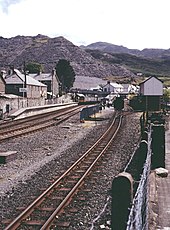Conwy Valley Line
| Llandudno – Blaenau Ffestiniog | |||||||||||||||||||||||||||||||||||||||||||||||||||||||||||||||||||||||||||||
|---|---|---|---|---|---|---|---|---|---|---|---|---|---|---|---|---|---|---|---|---|---|---|---|---|---|---|---|---|---|---|---|---|---|---|---|---|---|---|---|---|---|---|---|---|---|---|---|---|---|---|---|---|---|---|---|---|---|---|---|---|---|---|---|---|---|---|---|---|---|---|---|---|---|---|---|---|---|
|
Blaenau Ffestiniog train station today
| |||||||||||||||||||||||||||||||||||||||||||||||||||||||||||||||||||||||||||||
| Route length: | 49.6 km | ||||||||||||||||||||||||||||||||||||||||||||||||||||||||||||||||||||||||||||
| Gauge : | 1435 mm ( standard gauge ) | ||||||||||||||||||||||||||||||||||||||||||||||||||||||||||||||||||||||||||||
|
|||||||||||||||||||||||||||||||||||||||||||||||||||||||||||||||||||||||||||||
The Conwy Valley Line (also known as the Conwy Valley Railway , Welsh: Rheilffordd Dyffryn Conwy ) is a railway line in the north of Wales . It runs from Llandudno via Llandudno Junction (Welsh: Cyffordd Llandudno ) to Blaenau Ffestiniog and originally belonged to the London and North Western Railway (LNWR). The main purpose of the route, which was opened in stages from 1863 to 1881, was to transport slate from the quarries in Ffestiniog to a quay in Deganwy that was specially built for the export of slate by sea . The route also served freight traffic to the market town of Llanrwst and supplied many remote locations in Snowdonia via the extensive freight facilities in Betws-y-Coed on the trunk road from London to Holyhead . In addition, it served the emerging tourism.
history
The first section from Llandudno Junction to Llanrwst (now known as North Llanrwst) was built as the Conway and Llanrwst Railway and opened in 1863. The LNWR took over the route in the same year and opened the extension to Betws-y-Coed in 1868.

For the last section of the route to Blaenau Ffestiniog, the LNWR initially proposed a narrow-gauge railway through the steep Lledr Valley. After the start of construction, however, it was decided to build the extension as a standard-gauge railway in order to enable continuous train traffic. Between 1874 and 1879 the tunnel under the Moel Dyrnogydd was drilled, and in 1881 the entire route went into operation.
Originally, the Conwy Valley Line ended in a train station west of the city center that had extensive slate loading facilities. In the center of Blaenau Ffestiniog there was another train station, terminus of the Bala and Festiniog Railway operated by the Great Western Railway (GWR) . This line was closed in 1961 and partially flooded by the Llyn Celyn reservoir . Since a siding was required for the Trawsfynydd nuclear power plant, which is currently under construction , a short connecting line from the LNWR station to the demolished GWR station was built next to the tracks of the narrow-gauge Ffestiniog Railway, thus reconnecting the isolated section of the GWR to the railway network.
With the reconstruction of the Ffestiog Railway, a new community station was built a few years later in the city center at the site of the former GWR station, in which the Conwy Valley Line trains have ended since 1982. Beyond this station, the route only served freight to Trawsfynydd, although there were occasional special trains for people. The power station was shut down in 1991, and today the former connecting line is interrupted just behind the Blaenau Ffestiniog train station.
traffic
Although the Conwy Valley Line is only 50 kilometers long, the journey from Llandudno to Blaenau Ffestiniog takes approximately 75 minutes. Most of the stations along the route are demand stops .
From Llandudno to Llandudno Junction, trains use the double-track branch line of the North Wales Coast Line . From Llandudno Junction to Blaenau Ffestiniog, the line is single track and contains the longest single track rail tunnel in the UK (just over four kilometers long). The only alternative is at North Llanrwst station. Here, all trains have to stop at the signal box to exchange the tokens for the two adjacent single-track sections.
The trains are operated by Transport for Wales / Trafnidiaeth Cymru . They run every three hours on weekdays (Monday to Saturday); there are a total of six trains a day in each direction. In summer (from the beginning of the summer timetable in May to the beginning of September) there is also limited Sunday traffic with three trains in each direction.
Individual evidence
- ↑ Peter E. Baughan: A Regional History of the Railways of Great Britain: Volume 11 North and Mid Wales . 1st edition. David & Charles, Newton Abbot 1980, ISBN 0-7153-7850-3 , pp. 117 .
- ↑ Peter E. Baughan: A Regional History of the Railways of Great Britain: Volume 11 North and Mid Wales . 1st edition. David & Charles, Newton Abbot 1980, ISBN 0-7153-7850-3 , pp. 128-130 .
- ↑ a b Summer timetable 2013 ( Memento of the original from February 10, 2016 in the Internet Archive ) Info: The archive link was inserted automatically and has not yet been checked. Please check the original and archive link according to the instructions and then remove this notice. (English, PDF 93 kB)
Web links
- Rheilffordd Dyffryn Conwy - Conwy Valley Railway (Welsh and English)

